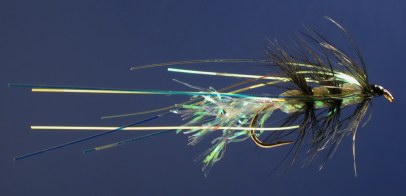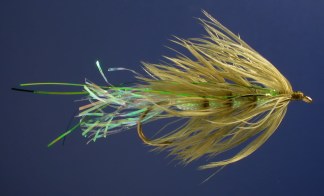Invicta Flies - Bead-Body Flashy Bugger
An original pattern from Erik Andreasson of Sweden that is sure to become one of your favorites. Using beads to create a full underbody, and individually wrapped soft hackles, this streamer presents bulky flash and plenty of movement. Strip it fast for anything, including trout, steelhead, perch, and bass. The flies featured here were tied by Erik.

Hook: standard streamer hook, such as TMC 300 (6x long), #6-8
Thread: 6/0, white & color to match hackle
Body: glow-in-the-dark beads (or other), pearl mylar tubing
Hackles: India hen, or other soft hackle
Flash: Flashabou Mirage
Tying Instructions:
1) Beads- those used here are glow-in-the-dark or "luminescent" beads generally used as attractors on saltwater rigs. These are oval in shape and are soft enough to slip over the hook eye. Other beads, glass or plastic can be used, and if they won't go over the hook eye, can be inserted onto the hook by way of the point. Crimp down the hook barb if necessary. Use a size of bead which, with all together, will cover 3/4 of the shank, depending on whether you want to have three (as above) or four sections (as shown below). Once the beads are on the hook, place it into the vise.
2) Secure the white thread to the hook at the bend. Cut a section of mylar tubing about two times the hook shank in length. To help prevent one end from coming unravelled, you can use tape or quick-drying glue. Unravel the other end for a length of about 2/3 to a full hook shank. Slip this over the shank of the hook, letting the unravelled end stradle the hook bend. Wrap the thread around the tubing where it's still woven, pull down on the thread to tighten, then take three more tight turns to secure. Whip finish the thread and clip. Cement the wraps.
3) Switch to a thread color that matches the hackle you'll be using. Gently pull the mylar tubing forward to tighten it slightly, at the same time pushing the rear bead back. Hold in place while you secure the thread over the tubing just in front of the bead (hold the bead inside the tubing and the tag end of the thread at the same time). Clip any excess thread. Note: alternately, you can tie down the mylar tubing behind the eye in front of the first bead, then whip finish and start the thread agian just in front of the rear bead. Just be sure to leave enough "slack" in the tubing to allow for tying down between the beads (this method also keeps the mylar from unravelling while you tie in the hackle).
3) Hackle- the hackle at the bend should have fibers about one and a half times the hook gap in length, and the proceeding hackles should have progressively longer fibers, with the final one (just behind the head) having fibers up to two and a half times the hook gap, or almost reaching the hook point. There are a couple of ways to accomplish this. One is to use a long saddle feather that tapers from a wide base to a finer tip, all the while maintaining a full web. A more consistent method, however, is to select three or four seperate feathers according to size. Choose the smallest, stroke the fibers near the tip backwards (where the fibers are the desired length and tie this in using three tight overlapping turns. Clip the excess tip. Take three or four full, touching turns, tie down with three tight overlapping wraps, then clip the excess. Wrap back over the last turn of hackle while holding the fibers back, then whip finish the thread (four turns, mostly overlapping), and clip. Cement the wraps.
4) Repeat the process for tying in the hackle in front of the rest of the beads, using the "next size up" for each succeeding tie-in. Before tying in the hackle in front of the first bead behind the head, tie in several strands of Flashabou in varying lengths (up to two times the hook length) on top of the shank. Proceed with the final hackle. Wrap a small head, whip finish, and cement.
